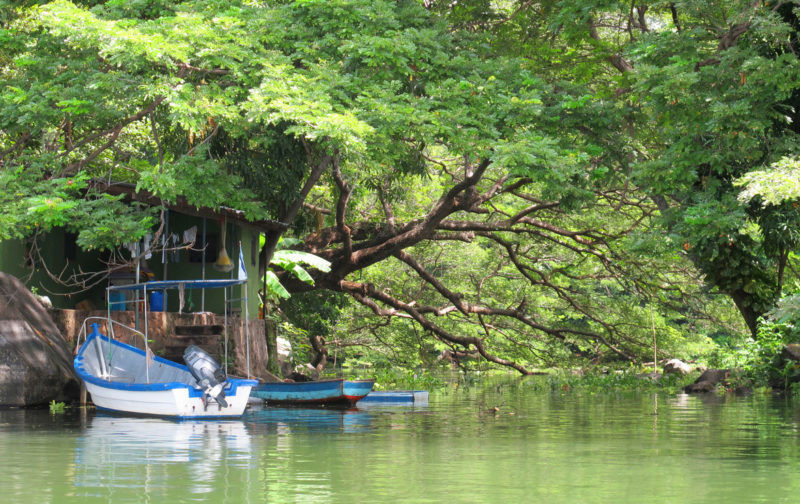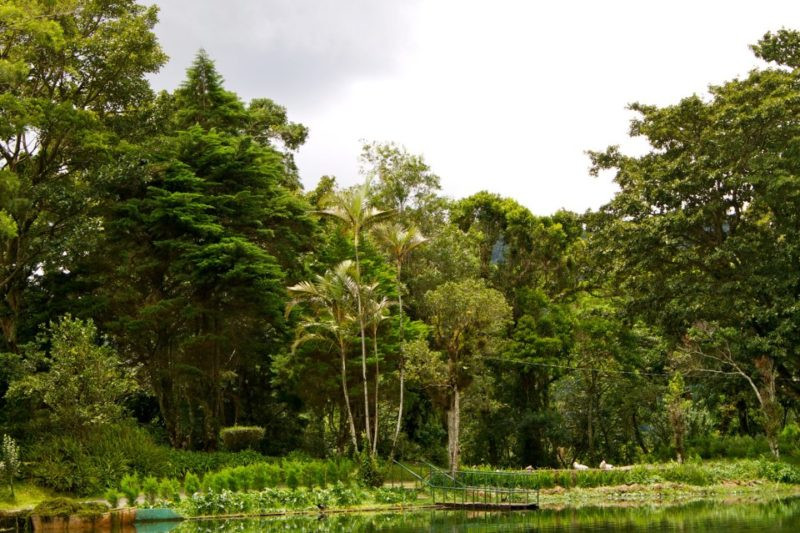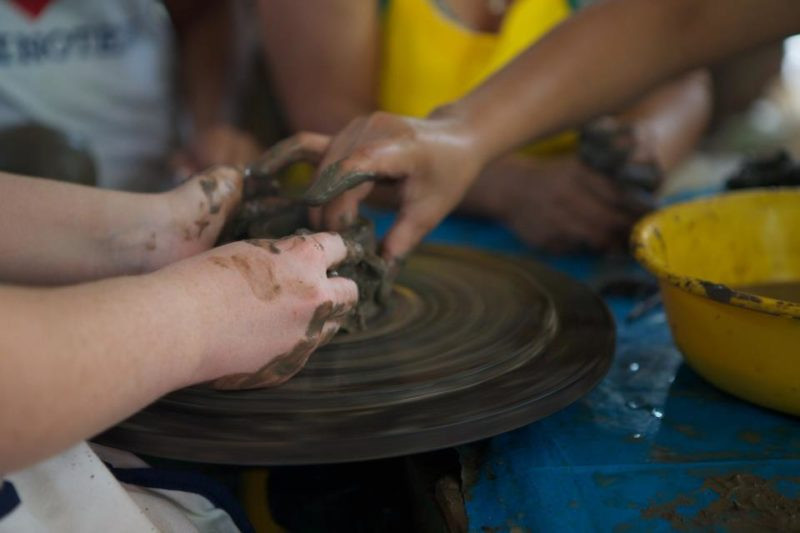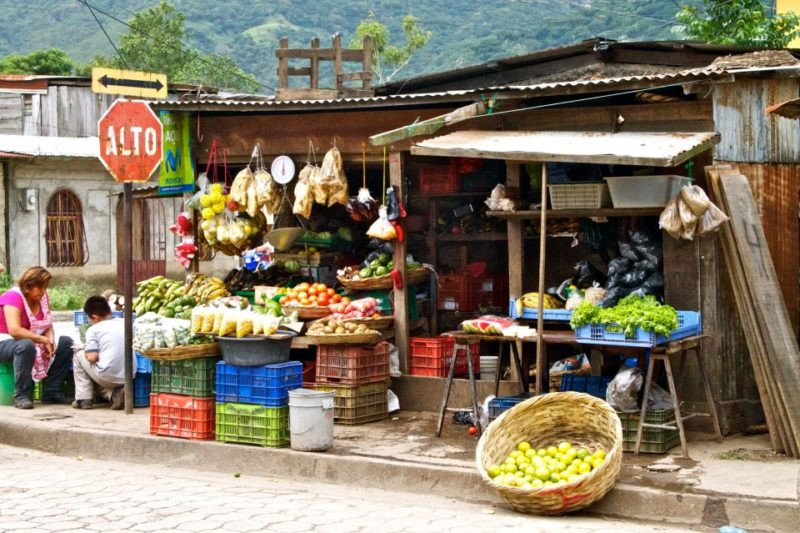Nicaragua Eco-tourism offers an incredible opportunity to explore stunning landscapes and support local communities, and SIXT.VN can help you plan your dream trip. From volcanoes and lakes to coffee plantations and indigenous crafts, discover the best of sustainable travel in Nicaragua with our expert guidance, airport transfers, hotel bookings, and tours. Explore responsible travel with our comprehensive eco-tourism guide, ensuring your journey contributes to sustainable tourism, environmental protection, and supports local communities.
1. Discover Nicaragua: The Land of Lakes and Volcanoes
Nicaragua, aptly nicknamed “the land of lakes and volcanoes,” is a must-visit destination for eco-tourists. To truly experience this incredibly biodiverse country, visitors should dedicate time to explore its distinctive natural features. According to the Nicaraguan Institute of Tourism (INTUR), ecotourism contributes significantly to the local economy, supporting sustainable development and conservation efforts.
1.1. Lake Nicaragua: A Freshwater Paradise
Lake Nicaragua, the country’s largest freshwater body, is a highlight of many tours through Nicaragua. The lake is renowned for its isletas, small islands that each possess unique characteristics and features.
 Isletas in Lake Nicaragua
Isletas in Lake Nicaragua
1.1.1. Ometepe Island: A Volcanic Marvel
Ometepe, a volcanic island formed by the Maderas and Concepción volcanoes (the latter still active), is perhaps the most captivating of these isletas. Hiking across the mountainside provides an immersive experience in serene tropical clearings. While on Ometepe, consider visiting La Via Verde Organic Farm for delicious homemade food and valuable tips on hiking, biking, bird watching, and fishing. This farm also offers relaxing spaces to unwind in a hammock.
1.1.2. Isla Zapatera: A Tranquil Escape
For those who prefer an island without an active volcano, Isla Zapatera is an excellent alternative. This island features an impressive National Park that is home to hundreds of species and some of the oldest petroglyphs on the planet. Located in the lake’s northwestern region, Zapatera is the second-largest isleta, offering a more off-the-beaten-path experience compared to Ometepe. You can even enjoy a swim in the many trickling streams and quiet pools scattered throughout the island, embodying la vida tranquila.
1.2. Los Guatuzos Wildlife Refuge: A Biodiversity Hotspot
At the southernmost shore of Lake Nicaragua lies the Los Guatuzos Wildlife Refuge, the only officially protected wetlands in Nicaragua, recognized by UNESCO. This refuge is home to hundreds of species year-round, with thousands more migrating annually. Los Guatuzos features a diverse mix of fauna, including lizards, amphibians, butterflies, tropical birds, monkeys, and the country’s elusive jaguar. The reserve also boasts an impressive array of flora, including 92 different orchid species. The Los Guatuzos Wildlife Refuge is an excellent choice for travelers interested in biodiversity and conservation. According to a study by the National Autonomous University of Nicaragua (UNAN), the refuge plays a crucial role in preserving the region’s ecological balance and supporting local communities through sustainable tourism.
2. How Does Nicaragua Eco-Tourism Support Sustainable Agriculture?
Nicaragua’s eco-tourism significantly bolsters sustainable agriculture by promoting practices that protect the environment and support local communities. According to the Food and Agriculture Organization of the United Nations (FAO), sustainable agriculture enhances biodiversity, reduces pollution, and improves soil health. Nicaragua has embraced this approach, particularly in its coffee-growing regions.
2.1. Selva Negra: A Model of Sustainable Coffee Farming
Coffee is a major export for Nicaragua, primarily grown in the northern highlands. Sustainable cultivation of coffee has become a central focus of the region’s eco-tourism efforts. Selva Negra, located in the Matagalpa district, exemplifies this type of eco-tourism. Nestled among lush tropical plants, this small compound features striking alpine architectural influences, a testament to the German immigrants who founded it in the late 19th century. Today, Selva Negra (‘Black Forest’) includes an organic farm, coffee plantation, and eco-lodge.
 Selva Negra Nicaragua
Selva Negra Nicaragua
Forest trails lead to spellbinding tropical scenery, flowing streams, and enormous trees, accompanied by the low growl of howler monkeys. The foggy, humid climate and unique animal sounds create a prehistoric atmosphere. Those interested in sustainable shade-grown coffee farming techniques can witness every step of the process, from harvesting the berries to processing the beans. Selva Negra’s restaurant serves organic farm-to-table products, with technicolor juice drinks like pitaya (prickly pear) and maracuya being popular choices.
3. Supporting the Human Aspect of Nicaragua Eco-Tourism: Community and Culture
Nicaragua eco-tourism also prioritizes the preservation of indigenous ways of life and supports local communities. Ecotourism has evolved to encompass not only natural ecosystems but also the cultural and economic well-being of local groups. According to a report by the World Tourism Organization (UNWTO), community-based tourism can significantly reduce poverty and promote cultural heritage.
3.1. Cooperativo San Expedito: Preserving Indigenous Pottery
To support the human side of sustainable tourism, consider visiting the women’s Black Pottery cooperative, Cooperativo San Expedito.
 Cooperativo San Expedito Nicaragua
Cooperativo San Expedito Nicaragua
The pottery of San Expedito is made according to indigenous traditions that have shaped the region for centuries. This includes ritualistically walking several kilometers to harvest and haul the black clay across the mountainous terrain and using manual pottery wheels. Profits from selling the ceramics to tourists support the women who reside in the Las Cureñas community. Visitors can learn the craft from the women and select from a wide array of creations, from incense holders to jewelry to dishware. You can also learn how these women use different rocks and minerals to polish the clay, all while their hens and pet dogs zigzag underfoot.
3.2. Soppexcca: Empowering Coffee Farmers in Jinotega
In the nearby town of Jinotega, the Soppexcca coffee collective is ideal for those who want to trace the stages of coffee beyond harvesting and drying the beans.
 Jinotega Nicaragua
Jinotega Nicaragua
As part of a union of 12 other collectives, Soppexcca is small-scale and highly localized. The establishment works towards achieving the UN’s Sustainable Development Goals by promoting women’s equality and helping to reduce childhood mortality. At the Jinotega location, they offer exclusive coffee tastings that provide insight into the commercial side of things, as guests learn the finer points of selecting the best varieties for sale around the world. Cooperativo San Expedito and Soppexcca are perfect for those looking to take home souvenirs that positively impact the lives of local Nicaraguans.
4. What are the Benefits of Eco-Tourism in Nicaragua?
Eco-tourism in Nicaragua offers numerous benefits, including environmental conservation, economic growth for local communities, and unique travel experiences for visitors. According to The International Ecotourism Society (TIES), eco-tourism is defined as responsible travel to natural areas that conserves the environment, sustains the well-being of the local people, and involves interpretation and education.
4.1. Environmental Conservation
Eco-tourism initiatives in Nicaragua focus on protecting natural ecosystems, preserving biodiversity, and promoting sustainable practices. According to a report by the United Nations Environment Programme (UNEP), eco-tourism can provide financial incentives for conservation, reduce deforestation, and protect endangered species.
4.2. Economic Growth for Local Communities
Eco-tourism provides economic opportunities for local communities through job creation, support for local businesses, and promotion of sustainable livelihoods. The World Bank reports that community-based tourism can significantly reduce poverty and improve living standards in rural areas.
4.3. Unique Travel Experiences
Eco-tourism offers travelers authentic and immersive experiences that connect them with nature, culture, and local communities. This includes activities such as hiking, bird watching, visiting organic farms, and participating in community-based projects.
5. Planning Your Nicaragua Eco-Tourism Trip with SIXT.VN
Planning an eco-tourism trip to Nicaragua can be both exciting and overwhelming. SIXT.VN offers comprehensive services to ensure your trip is seamless, sustainable, and unforgettable.
5.1. Expert Travel Consultation
SIXT.VN provides expert travel consultation to help you design an itinerary that aligns with your interests and preferences. Our knowledgeable travel advisors can provide insights on the best eco-tourism destinations, sustainable accommodations, and responsible tour operators in Nicaragua.
5.2. Convenient Airport Transfers
SIXT.VN offers convenient and reliable airport transfer services to ensure a smooth arrival and departure. Our professional drivers will greet you at the airport and transport you to your hotel or other destinations in comfort and safety.
Contact: Address: 260 Cau Giay, Hanoi, Vietnam. Hotline/Whatsapp: +84 986 244 358. Website: SIXT.VN
5.3. Hotel Booking Services
SIXT.VN offers a wide range of hotel options to suit your budget and preferences. We partner with eco-friendly hotels and lodges that prioritize sustainability and support local communities.
5.4. Guided Eco-Tours
SIXT.VN organizes guided eco-tours that showcase the natural beauty and cultural heritage of Nicaragua. Our experienced guides will take you on immersive adventures, providing valuable insights into the local environment and culture.
6. What Key Attractions Await in Nicaragua?
Nicaragua is famous for its diverse attractions, which range from historical sites to pristine natural landscapes. Nicaragua offers something for everyone, making it the perfect place to visit. Some of the most popular destinations consist of:
- Granada: A colonial city on the shores of Lake Nicaragua, known for its colorful architecture.
- León: Another colonial city with a rich history and vibrant culture.
- Ometepe Island: A volcanic island in Lake Nicaragua, offering hiking, wildlife viewing, and stunning scenery.
- San Juan del Sur: A popular surfing town on the Pacific coast, known for its beautiful beaches.
- Corn Islands: Two Caribbean islands with pristine beaches, clear waters, and laid-back vibes.
7. What Essential Travel Tips Should I Consider for Nicaragua?
Traveling in Nicaragua can be a rewarding experience if you’re prepared. Here are some essential travel tips to ensure a safe and enjoyable trip:
- Visa and Entry Requirements: Ensure your passport is valid for at least six months beyond your planned stay. Check visa requirements based on your nationality.
- Health and Safety: Consult your doctor regarding necessary vaccinations and health precautions. Drink bottled water and be cautious with street food.
- Currency and Payment: The official currency is the Nicaraguan Córdoba (NIO). US dollars are widely accepted. Credit cards are accepted in larger establishments but not in smaller, local venues.
- Language: Spanish is the official language. Learning basic Spanish phrases will enhance your travel experience.
- Transportation: Buses are a common and affordable way to travel between cities. Taxis are available in urban areas. Consider renting a car for more flexibility, especially for exploring rural areas.
- Cultural Sensitivity: Respect local customs and traditions. Dress modestly when visiting religious sites.
- Safety: Be aware of your surroundings and avoid walking alone at night. Keep valuables secure and avoid displaying wealth.
- Weather: Nicaragua has a tropical climate. The dry season is from December to April, and the rainy season is from May to November. Pack accordingly.
- Internet Access: Wi-Fi is available in many hotels and restaurants, but it can be unreliable. Consider purchasing a local SIM card for more consistent internet access.
- Emergency Contacts: Keep a list of emergency contacts, including your embassy or consulate, local police, and medical facilities.
8. What Exciting Activities Await Me in Nicaragua?
Nicaragua offers a wide array of activities that cater to various interests and preferences. Some of the most popular activities include:
- Volcano Boarding: Descend the slopes of Cerro Negro volcano on a wooden board.
- Hiking: Explore the country’s numerous volcanoes, forests, and national parks.
- Surfing: Catch waves at popular surfing spots like San Juan del Sur and Playa Maderas.
- Wildlife Viewing: Observe diverse wildlife in protected areas like Los Guatuzos Wildlife Refuge and Indio Maíz Biological Reserve.
- Cultural Tours: Visit historical sites, museums, and cultural centers in Granada and León.
- Coffee Plantation Tours: Learn about coffee cultivation and processing at sustainable coffee farms.
- Island Hopping: Explore the isletas of Lake Nicaragua and the Corn Islands.
- Yoga and Wellness Retreats: Relax and rejuvenate at yoga and wellness retreats in serene locations.
- Scuba Diving and Snorkeling: Discover vibrant marine life in the clear waters of the Caribbean Sea.
- Fishing: Enjoy fishing in Lake Nicaragua or the Pacific Ocean.
9. What are the Benefits of Choosing SIXT.VN for Your Nicaragua Trip?
Choosing SIXT.VN for your Nicaragua trip ensures a hassle-free, enjoyable, and sustainable travel experience. Here are some key benefits:
9.1. Comprehensive Services
SIXT.VN offers a full range of travel services, including flight booking, airport transfers, hotel booking, guided tours, and travel insurance. This one-stop-shop approach simplifies the planning process and ensures all your needs are met.
9.2. Expert Guidance
Our experienced travel advisors provide expert guidance and personalized recommendations to help you create the perfect itinerary. We offer valuable insights on the best destinations, activities, and sustainable practices in Nicaragua.
9.3. Sustainable Travel Options
SIXT.VN is committed to promoting sustainable tourism in Nicaragua. We partner with eco-friendly accommodations, responsible tour operators, and local communities to minimize our environmental impact and support local economies.
9.4. Competitive Pricing
We offer competitive pricing on all our services, ensuring you get the best value for your money. Our transparent pricing policy means no hidden fees or surprises.
9.5. 24/7 Customer Support
SIXT.VN provides 24/7 customer support to assist you with any questions or concerns before, during, and after your trip. Our dedicated support team is always available to ensure your travel experience is seamless and stress-free.
10. What are the Common FAQs About Eco-Tourism in Nicaragua?
Here are some frequently asked questions (FAQs) about eco-tourism in Nicaragua:
10.1. What is eco-tourism?
Eco-tourism is responsible travel to natural areas that conserves the environment, sustains the well-being of the local people, and involves interpretation and education.
10.2. Why choose Nicaragua for eco-tourism?
Nicaragua offers diverse ecosystems, rich biodiversity, and a commitment to sustainable development, making it an ideal destination for eco-tourism.
10.3. What are the best eco-tourism destinations in Nicaragua?
Some of the best eco-tourism destinations in Nicaragua include Lake Nicaragua, Los Guatuzos Wildlife Refuge, Selva Negra, and Ometepe Island.
10.4. How can I ensure my trip to Nicaragua is sustainable?
You can ensure your trip is sustainable by choosing eco-friendly accommodations, supporting local businesses, participating in responsible tours, and respecting local customs and traditions.
10.5. What activities can I do in Nicaragua that support eco-tourism?
Activities that support eco-tourism include hiking, bird watching, visiting organic farms, participating in community-based projects, and staying in eco-lodges.
10.6. What should I pack for an eco-tourism trip to Nicaragua?
Pack lightweight clothing, comfortable hiking shoes, insect repellent, sunscreen, a hat, and a reusable water bottle.
10.7. Is it safe to travel to Nicaragua?
Nicaragua is generally safe for tourists, but it’s important to be aware of your surroundings, avoid walking alone at night, and keep valuables secure.
10.8. What is the best time to visit Nicaragua for eco-tourism?
The best time to visit Nicaragua for eco-tourism is during the dry season, from December to April, when the weather is pleasant and there is less rain.
10.9. How can SIXT.VN help me plan my eco-tourism trip to Nicaragua?
SIXT.VN offers expert travel consultation, convenient airport transfers, hotel booking services, guided eco-tours, and 24/7 customer support to ensure a seamless and sustainable travel experience.
10.10. What are the visa requirements for Nicaragua?
Visa requirements for Nicaragua vary depending on your nationality. Check the Nicaraguan embassy or consulate website in your country for the most up-to-date information.
Nicaragua offers a unique and enriching travel experience, blending natural beauty with cultural richness and a commitment to sustainability. By planning your trip with SIXT.VN, you can ensure a seamless, responsible, and unforgettable adventure. Explore the lakes, volcanoes, and vibrant communities of Nicaragua, knowing that your journey contributes to the preservation of this extraordinary destination.
From its cosmopolitan cities to its breathtaking natural beauty, Nicaragua has something for everyone within its borders. Eco-tourism, in particular, is flourishing.
Ready to embark on your Nicaragua eco-tourism adventure? Contact SIXT.VN today to start planning your dream trip. Visit our website or call our hotline to learn more about our services and special offers. Let us help you create a sustainable and unforgettable journey to the heart of Central America!
Contact: Address: 260 Cau Giay, Hanoi, Vietnam. Hotline/Whatsapp: +84 986 244 358. Website: SIXT.VN.



